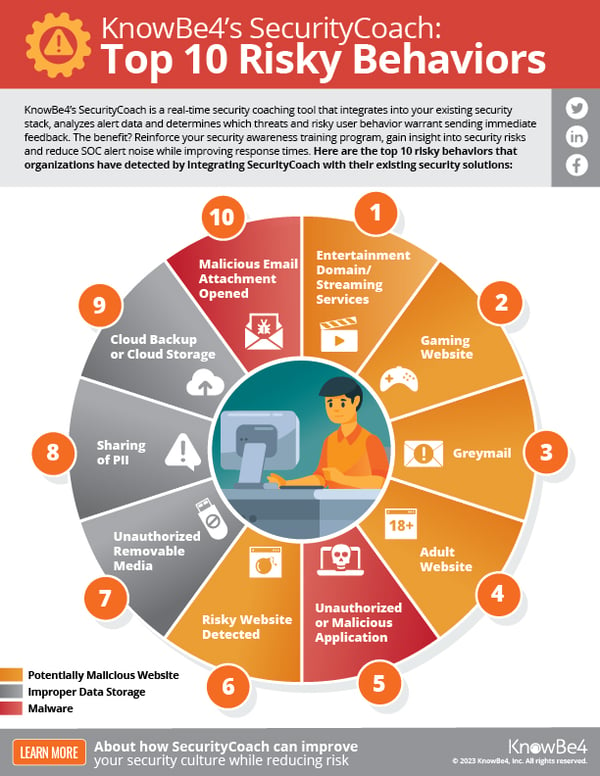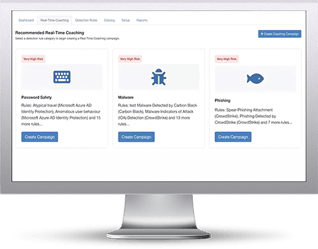Real-time security coaching helps improve your organization’s security culture by enabling real-time coaching of your users in response to risky security behaviors.
KnowBe4’s SecurityCoach integrates with an organization’s existing security stack, analyzes alert data and determines which threats and risky behavior warrant sending immediate feedback.
The benefits? It leverages your existing security products so you get additional value from them. It allows you to take a data-driven approach to quantifying and reducing human risk by combining existing technology with real-time behavior coaching. And lastly, it reduces the burden on your SOC team by decreasing alert noise caused by repetitive, risky user behaviors.
Download the full infographic (PDF).
Here are the top 10 risky behaviors that SecurityCoach users have detected by integrating it with their existing security products:
- Entertainment Domain/Streaming Services
- Gaming Website
- Greymail
- Adult Website
- Unauthorized or Malicious Application
- Risky Website Detected
- Unauthorized Removable Media
- Sharing of PII
- Cloud Backup or Cloud Storage
- Malicious Email Attachment Opened
“With the proliferation of social engineering attacks, employees continue to be the biggest risk factor,” said Stu Sjouwerman, CEO, KnowBe4. “However, with proper training and coaching, they can become a human firewall and your last line of defense. These findings from our new SecurityCoach product are definitely concerning and reiterate the importance of developing a strong security culture.”
A New Approach to Building A Strong Security Culture
Real-time coaching is a new approach to cybersecurity that focuses on identifying and responding to threats that originate from human activity, such as phishing attacks or social engineering tactics. Traditional security awareness training (SAT), on the other hand, aims to educate employees on best practices for staying secure online and avoiding common cybersecurity risks.
A key difference between real-time coaching and SAT is what it focuses on. While SAT typically emphasizes prevention, real-time coaching focuses on analyzing and responding to security incidents that have already infiltrated an organization. This can include monitoring network traffic for unusual behavior, analyzing user behavior to identify potential insider threats, and users neglecting to follow an organization’s IT policies.
Real-time coaching and SAT are complementary. By enabling users to make better security decisions, SAT helps prevent many common social engineering threats. Meanwhile, real-time coaching provides an added automated layer of protection by analyzing and responding to threats that may have slipped through the cracks, thereby serving as a reinforcement to SAT. Combined, security awareness training and real-time coaching help to actively reduce risk to organizations.







